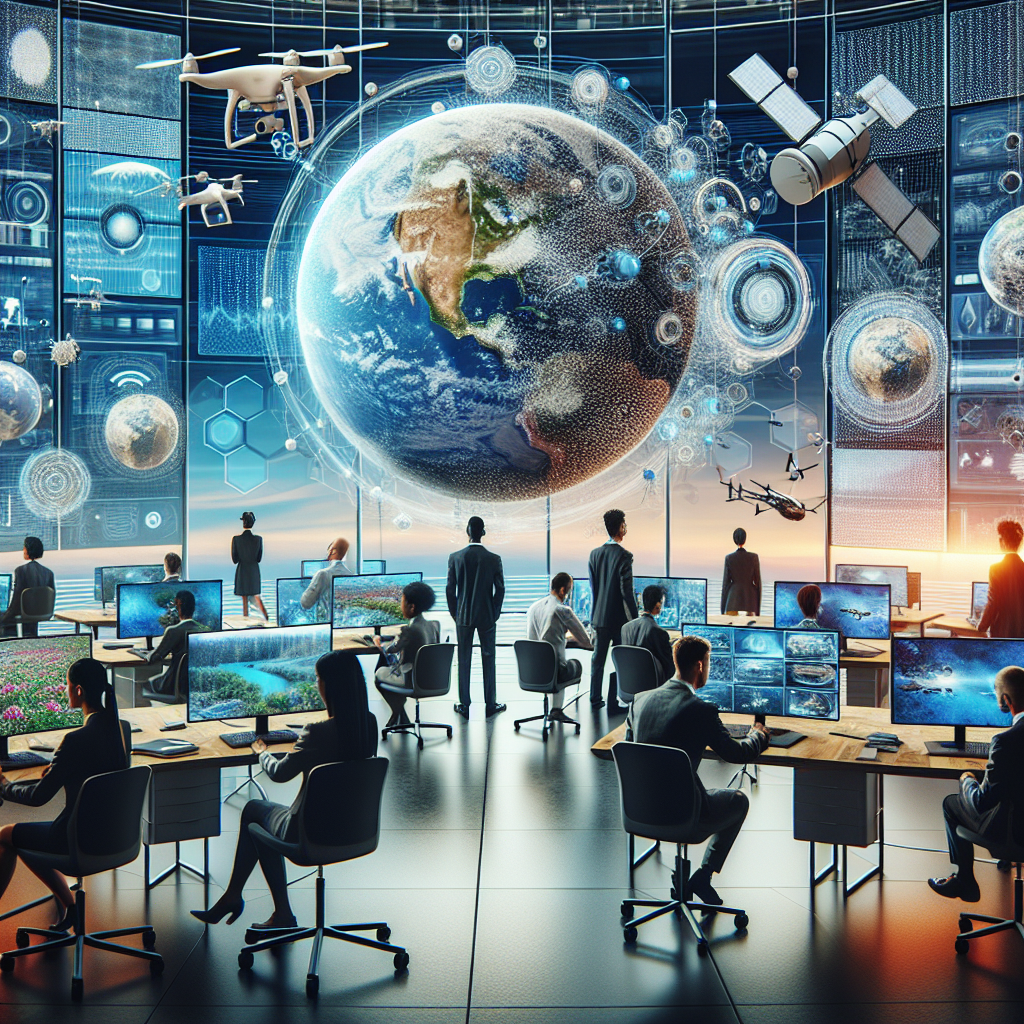-
Table of Contents
“Empowering a Greener Future Through Advanced Environmental Monitoring Technology”
Introduction

Technology is revolutionizing the field of environmental monitoring by providing advanced tools and methods to collect, analyze, and interpret data with unprecedented accuracy and efficiency. Innovations such as remote sensing, satellite imagery, and Internet of Things (IoT) devices enable real-time tracking of environmental parameters, from air and water quality to deforestation and wildlife habitats. These technological advancements facilitate more comprehensive and timely assessments, allowing for better-informed decision-making and more effective environmental management. Additionally, big data analytics and machine learning algorithms enhance predictive capabilities, helping to anticipate and mitigate environmental issues before they escalate. As a result, technology is playing a crucial role in safeguarding ecosystems and promoting sustainable development.
Advanced Sensor Technologies for Real-Time Environmental Data Collection
In recent years, the intersection of technology and environmental science has given rise to advanced sensor technologies that are revolutionizing the way we monitor our planet. These innovations are not only providing real-time data but are also enhancing our ability to respond to environmental changes more swiftly and effectively. As we delve into the world of advanced sensor technologies, it becomes evident that their impact on environmental monitoring is profound and far-reaching.
One of the most significant advancements in this field is the development of sophisticated sensors capable of detecting minute changes in environmental conditions. These sensors, often embedded in various devices, can measure a wide range of parameters, including temperature, humidity, air quality, and water quality. For instance, air quality sensors can detect pollutants such as carbon monoxide, sulfur dioxide, and particulate matter, providing crucial data that can help mitigate the effects of air pollution on public health.
Moreover, the integration of Internet of Things (IoT) technology with these sensors has further amplified their capabilities. IoT-enabled sensors can transmit data in real-time to centralized systems, allowing for continuous monitoring and immediate analysis. This real-time data collection is invaluable for environmental scientists and policymakers, as it enables them to make informed decisions quickly. For example, in the event of a sudden spike in air pollution levels, authorities can issue timely warnings to the public and implement measures to reduce emissions.
In addition to air quality monitoring, advanced sensor technologies are making significant strides in water quality assessment. Traditional methods of water sampling and laboratory analysis are often time-consuming and may not provide a comprehensive picture of water quality. However, modern sensors can continuously monitor various water parameters, such as pH levels, turbidity, and the presence of contaminants like heavy metals and pathogens. This continuous monitoring is particularly crucial for safeguarding drinking water sources and protecting aquatic ecosystems.
Transitioning from water to land, soil sensors are another remarkable innovation in environmental monitoring. These sensors can measure soil moisture, temperature, and nutrient levels, providing essential data for agriculture and land management. Farmers can use this information to optimize irrigation practices, reduce water usage, and enhance crop yields. Additionally, soil sensors can help detect early signs of soil degradation and erosion, enabling timely interventions to preserve soil health.
Furthermore, the advent of remote sensing technologies, such as drones and satellites, has expanded the scope of environmental monitoring. Equipped with advanced sensors, these aerial platforms can cover vast areas and collect data on various environmental parameters. For instance, drones can capture high-resolution images of forests, wetlands, and coastal areas, helping researchers monitor changes in vegetation, track wildlife populations, and assess the impact of natural disasters. Satellites, on the other hand, provide a global perspective, offering valuable insights into climate patterns, deforestation rates, and ocean health.
As we continue to explore the potential of advanced sensor technologies, it is essential to recognize the role of data analytics and artificial intelligence (AI) in enhancing environmental monitoring. The sheer volume of data generated by these sensors can be overwhelming, but AI algorithms can process and analyze this data efficiently. By identifying patterns and trends, AI can provide actionable insights and predictive models, enabling proactive environmental management.
In conclusion, advanced sensor technologies are transforming the landscape of environmental monitoring, offering unprecedented opportunities for real-time data collection and analysis. From air and water quality to soil health and remote sensing, these innovations are empowering us to better understand and protect our environment. As technology continues to evolve, the synergy between sensors, IoT, and AI promises to further enhance our ability to monitor and respond to environmental challenges, ultimately contributing to a more sustainable future.
The Role of Artificial Intelligence in Predicting Environmental Changes
Artificial intelligence (AI) is revolutionizing the way we monitor and predict environmental changes, offering unprecedented accuracy and efficiency. As the world grapples with climate change, deforestation, and pollution, the need for advanced tools to understand and mitigate these issues has never been more critical. AI, with its ability to process vast amounts of data and identify patterns, is emerging as a powerful ally in this endeavor.
One of the most significant ways AI is enhancing environmental monitoring is through the analysis of satellite imagery. Satellites capture extensive data about the Earth’s surface, but the sheer volume of information can be overwhelming for human analysts. AI algorithms, however, can sift through these images quickly and accurately, identifying changes in land use, deforestation rates, and even the health of coral reefs. For instance, AI-powered tools can detect illegal logging activities in real-time, allowing authorities to take swift action to protect endangered forests.
Moreover, AI is playing a crucial role in predicting weather patterns and natural disasters. Traditional weather forecasting models rely on historical data and complex mathematical equations, but they often fall short in predicting extreme weather events. AI, on the other hand, can analyze real-time data from various sources, such as weather stations, satellites, and ocean buoys, to provide more accurate and timely forecasts. This capability is particularly valuable in predicting hurricanes, floods, and droughts, enabling communities to prepare and respond more effectively.
In addition to weather prediction, AI is also being used to monitor air and water quality. Sensors placed in strategic locations can collect data on pollutants and other environmental factors. AI algorithms then analyze this data to identify trends and potential sources of contamination. For example, AI can help pinpoint industrial activities contributing to air pollution or identify agricultural runoff affecting water quality. By providing this level of detail, AI enables policymakers and environmental agencies to implement targeted measures to reduce pollution and protect public health.
Furthermore, AI is facilitating the study of biodiversity and wildlife conservation. Traditional methods of tracking animal populations and movements can be labor-intensive and invasive. AI-powered tools, such as camera traps and drones equipped with image recognition software, offer a non-intrusive alternative. These tools can automatically identify and count species, monitor their behaviors, and even detect poaching activities. This wealth of data helps conservationists develop more effective strategies to protect endangered species and their habitats.
Transitioning to renewable energy sources is another area where AI is making a significant impact. The integration of AI in smart grids allows for better management of energy resources, optimizing the distribution and consumption of electricity. AI can predict energy demand, identify inefficiencies, and even forecast the output of renewable energy sources like solar and wind. This not only enhances the reliability of renewable energy but also reduces the reliance on fossil fuels, contributing to a reduction in greenhouse gas emissions.
In conclusion, the role of artificial intelligence in predicting environmental changes is multifaceted and transformative. By harnessing the power of AI, we can gain deeper insights into the complex dynamics of our environment, enabling more informed decision-making and proactive measures. As technology continues to advance, the potential for AI to contribute to environmental sustainability will only grow, offering hope for a more resilient and sustainable future.
Satellite Imaging and Remote Sensing for Comprehensive Ecosystem Monitoring
In recent years, the intersection of technology and environmental science has opened up new avenues for monitoring and preserving our planet’s ecosystems. One of the most transformative advancements in this field is the use of satellite imaging and remote sensing. These technologies are revolutionizing the way scientists and environmentalists observe and understand the natural world, providing comprehensive data that was previously unattainable.
Satellite imaging, for instance, offers a bird’s-eye view of the Earth’s surface, capturing high-resolution images that can be analyzed to track changes in land use, vegetation cover, and even the health of forests. This capability is particularly valuable for monitoring deforestation, a pressing issue that has significant implications for biodiversity and climate change. By comparing satellite images taken over time, researchers can identify areas where illegal logging is occurring, enabling authorities to take swift action to protect these vital ecosystems.
Moreover, remote sensing technology complements satellite imaging by providing additional layers of data through various sensors. These sensors can detect a range of environmental parameters, such as temperature, humidity, and soil moisture levels. This information is crucial for understanding the dynamics of different ecosystems and predicting how they might respond to changing climatic conditions. For example, remote sensing can help track the progression of droughts, allowing for better water resource management and agricultural planning.
Transitioning from terrestrial to aquatic environments, satellite imaging and remote sensing also play a pivotal role in monitoring the health of oceans and coastal areas. These technologies can detect changes in sea surface temperatures, track the movement of harmful algal blooms, and even monitor coral reef health. The ability to gather such detailed information from space is invaluable for marine conservation efforts, as it enables scientists to identify and address threats to marine biodiversity more effectively.
Furthermore, the integration of artificial intelligence (AI) and machine learning with satellite imaging and remote sensing is enhancing the accuracy and efficiency of environmental monitoring. AI algorithms can process vast amounts of data quickly, identifying patterns and anomalies that might be missed by human analysts. This capability is particularly useful for early warning systems, such as those used to predict natural disasters like hurricanes and wildfires. By providing timely and accurate information, these systems can help mitigate the impact of such events on both human populations and natural ecosystems.
In addition to their scientific applications, satellite imaging and remote sensing are also proving to be valuable tools for policy-making and environmental governance. Governments and international organizations can use the data collected by these technologies to inform their decisions on land use planning, conservation strategies, and climate change mitigation. For instance, satellite data can help track the progress of reforestation projects, ensuring that they are meeting their targets and contributing to carbon sequestration goals.
As we look to the future, the potential for satellite imaging and remote sensing to enhance environmental monitoring is immense. Continued advancements in sensor technology, data processing, and AI will undoubtedly lead to even more sophisticated and comprehensive monitoring capabilities. This, in turn, will enable us to better understand and protect our planet’s diverse ecosystems, ensuring their health and resilience for generations to come.
In conclusion, the marriage of technology and environmental science through satellite imaging and remote sensing is providing unprecedented insights into the state of our planet. By offering a comprehensive and detailed view of ecosystems, these technologies are empowering scientists, policymakers, and conservationists to make informed decisions that promote environmental sustainability. As we continue to harness the power of these tools, we can look forward to a future where our ability to monitor and protect the natural world is more effective than ever before.
Conclusion
Technology is significantly enhancing environmental monitoring by providing advanced tools and methods for data collection, analysis, and dissemination. Innovations such as remote sensing, satellite imagery, IoT sensors, and AI-driven analytics enable real-time tracking of environmental parameters, leading to more accurate and comprehensive understanding of ecological changes. These advancements facilitate early detection of environmental issues, improve resource management, and support informed decision-making for conservation efforts. Consequently, technology is playing a crucial role in promoting sustainability and protecting natural ecosystems.





